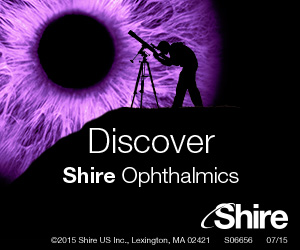
A
weekly e-journal by Art Epstein, OD, FAAO
Off the Cuff: The Problem is Not Too Many Schools
Like most of you, I’ve watched the opening of new programs around the country—often in locations that already had existing schools, like Boston and Chicago, with growing alarm. As luck would have it, I ran into my old friend and teacher, Dr. Andrew Buzzelli in Boston last week. As a student at SUNY in the late 70s, a very young Andy Buzzelli, then fresh out of the military was inspirational. Military in demeanor, buzz cut and all, Andy confused the heck out of us with his focus on Vermont. It just didn’t seem to fit his commanding presence.
|
|||||
 |
||
| Dominant Eye & Visual Evoked Potential in Myopic Anisometropia | ||||
A prospective, nonrandomized, controlled study was conducted to explore the association between ocular dominance and degree of myopia in patients with anisometropia, and to investigate the character of visual evoked potential (VEP) in high anisometropias. A total of 1,771 young myopia cases, including 790 anisometropias, were recruited. Researchers found no significant relation between ocular dominance and spherical equivalent (SE) refraction in all subjects. On average for subjects with anisometropia 1.0D to 1.75 D, there was no significant difference in SE power between dominant and nondominant eyes, while in the SE anisometropia ≥1.75 D group, the degree of myopia was significantly higher in nondominant eyes than in dominant eyes. The trend was more significant in the SE anisometropia ≥2.5 D group. No significant difference in higher-order aberrations was detected between dominant eye and nondominant eye either in the whole study candidates or in any anisometropia groups. In anisometropias >2.0 D, the N75 latency of nondominant eye was longer than that of dominant eye. These results suggested that, with the increase of anisometropia, the nondominant eye had a tendency of higher refraction, and N75 wave latency of nondominant eye was longer than that of dominant eye in high anisometropias. |
||||
| SOURCE: Wang Q, Wu Y, Liu W, Gao L. Dominant Eye and Visual Evoked Potential of Patients with Myopic Anisometropia. Biomed Res Int. 2016;2016:5064892. Epub 2016 Jun 2. | ||||

|
||
| What is a Typical Optic Nerve Head? | ||||
Whereas it is known that elevated intraocular pressure (IOP) increases the risk of glaucoma, it is not known why optic nerve heads (ONHs) vary so much in sensitivity to IOP and how this sensitivity depends on the characteristics of the ONH such as tissue mechanical properties and geometry. It is often assumed that ONHs with uncommon or atypical sensitivity to IOP, high sensitivity in normal tension glaucoma or high robustness in ocular hypertension also have atypical ONH characteristics. Here, researchers address two specific questions quantitatively: Do atypical ONH characteristics necessarily lead to atypical biomechanical responses to elevated IOP? And, do typical biomechanical responses necessarily come from ONHs with typical characteristics. Researchers generated 100,000 ONH numerical models with randomly selected values for the characteristics, all falling within literature ranges of normal ONHs. The models were solved to predict their biomechanical response to an increase in IOP. Researchers classified ONH characteristics and biomechanical responses into typical or atypical using a percentile-based threshold, and calculated the fraction of ONHs for which the answers to the two questions were true and/or false. They then studied the effects of varying the percentile threshold. Researchers found that when they classified the extreme 5% of individual ONH characteristics or responses as atypical, only 28% of ONHs with an atypical characteristic had an atypical response. Further, almost 29% of typical responses came from ONHs with at least one atypical characteristic. Thus, the answer to both questions is no. This answer held irrespective of the threshold for classifying typical or atypical. The results challenge the assumption that ONHs with atypical sensitivity to IOP must have atypical characteristics. This finding suggests that the traditional approach of identifying risk factors by comparing characteristics between patient groups (e.g. ocular hypertensive vs. primary open angle glaucoma) may not be a sound strategy. |
||||
SOURCE: Voorhees AP, Grimm JL, Bilonick RA, et al. What is a typical optic nerve head? Exp Eye Res. 2016 Jun 20. pii: S0014-4835(16)30160-9. [Epub ahead of print] |
||||
 |
||
| Advanced Drug Delivery & Targeting Technologies for Ocular Diseases | ||||
Ocular targeted therapy has been enormously advanced by implementation of new methods of drug delivery and targeting using implantable drug delivery systems (DDSs) or devices (DDDs), stimuli-responsive advanced biomaterials, multimodal nanomedicines, cell therapy modalities and medical bioMEMs. These technologies tackle several ocular diseases such as inflammation-based diseases (e.g., scleritis, keratitis, uveitis, iritis, conjunctivitis, chorioretinitis, choroiditis, retinitis and retinochoroiditis), ocular hypertension and neuropathy, age-related macular degeneration and mucopolysaccharidosis (MPS) due to accumulation of glycosaminoglycans (GAGs). Such therapies appear to provide ultimate treatments, even though much more effective, yet biocompatible, noninvasive therapies are needed to control some disabling ocular diseases/disorders. In the current study, investigators reviewed and discussed recent advancements on ocular targeted therapies. On the ground that the pharmacokinetic and pharmacodynamic analyses of ophthalmic drugs need special techniques, most ocular DDSs/devices developments have been designed to localized therapy within the eye. Application of advanced DDSs such as subconjunctival insert/implants (e.g., latanoprost implant, Gamunex-C), episcleral implant (e.g., LX201), cationic emulsions (e.g., Cationorm™, Vekacia™, Cyclokat™), intac/punctal plug DDSs (latanoprost punctal plug delivery system, L-PPDS), and intravitreal implants (I-vitaion™, NT-501, NT- 503, MicroPump, Thethadur, IB-20089 Verisome™, Cortiject, DE-102, Retisert™, Iluvein™ and Ozurdex™) have significantly improved the treatment of ocular diseases. However, most of these DDSs/devices are applied invasively and even need surgical procedures. Of these, use of de novo technologies such as advanced stimuli-responsive nanomaterials, multimodal nanosystems (NSs)/nanoconjugates (NCs), biomacromolecualr scaffolds and bioengineered cell therapies need to be further advanced to get better compliance and higher clinical impacts. Despite many successful battles against ocular diseases, investigators wrote that strategies to address ocular diseases that occur with aging are ongoing. They wrote further that understanding the molecular aspects of eye diseases in a holistic way and developing ultimate treatment protocols, preferably as noninvasive systems, are essential to making further strides toward that end. |
||||
SOURCE: Barar J, Aghanejad A, Fathi M, Omidi Y. Advanced drug delivery and targeting technologies for the ocular diseases. Bioimpacts. 2016;6(1):49-67. Epub 2016 Mar 30. |
||||
 |
||
| News & Notes | |
| Allergan Donates Refresh Eye Drops to First Responders Allergan exceeded its goal of donating $1 million worth of Refresh eye drops to America’s first responders. Last summer, Allergan kicked off the Refresh America campaign aiming to help emergency personnel alleviate discomfort from dry eye symptoms brought on by exposure to elements such as heat, wind, smoke and dust. Every purchase of specially marked packages in the Refresh Optive product line since August 2015 has led to more than 80,000 donations of eye drops. Read more. |
|
| Eyenuk Announces CE Mark and Commercial Launch of EyeArt 2.0 Eyenuk announced receipt of the CE Mark and launch of the second generation of its fully automated diabetic retinopathy screening software. The company plans to roll out EyeArt 2.0 to select eye-care centers in Europe over the next few months. The commercial launch is supported by a new study of the technology demonstrating 98.3 percent sensitivity in identifying potentially treatable patients with severe nonproliferative or proliferative DR, and/or the presence of surrogate markers for clinically significant macular edema. Read more. |
|
| ReVision Optics Receives FDA Approval for the Raindrop Near Vision Inlay ReVision Optics received U.S. Food and Drug Administration approval for the Raindrop Near Vision Inlay, a novel corneal inlay for the surgical correction of presbyopia indicated to improve near vision by reshaping the anterior curvature of the cornea in presbyopic patients who have emmetropic refractions (+1.00 D to -0.50 D). Results from the study submitted to the FDA in the company’s Premarket Approval application showed clinically significant improvement in near visual performance. Read more. | |
| Alcon Showcases Latest Developments at 2016 Optometry’s Meeting Alcon previewed Dailies Total1 multifocal contact lenses, designed with water gradient technology for patients with presbyopia, at this year’s Optometry’s Meeting. Attendees had the opportunity to learn about the technology in Alcon’s and to learn more from S. Barry Eiden, OD, who was expected to introduce this innovation at an Alcon-sponsored educational event to be held on July 1. In addition, Alcon featured expanded parameters for Dailies Total1 and Dailies AquaComfort Plus, and will showcase the company’s full vision care portfolio of differentiated products. Also on display will be Alcon’s commitment to partnerships with patients, practitioners, students and organizations. Visitors can interact with a patient-focused, free e-book called Howard and the Amazing Eye Exam to encourage parents and children to learn about comprehensive eye exams, and learn more about our partnership with Think About Your Eyes, a national campaign to promote the importance of eye health. | |
| Owl Accepts Nominations for the 2016 Owl Awards OWL, a national, not-for-profit organization dedicated to driving ophthalmic innovation and patient care by advancing diversity in leadership, is accepting nominations for the 2016 OWL Awards. The awards include the Visionary, Catalyst and Rising Star awards. The deadline for nominations is July 18. Learn more. | |
|
Optometric Physician™ (OP) newsletter is owned and published by Dr. Arthur Epstein. It is distributed by the Review Group, a Division of Jobson Medical Information LLC (JMI), 11 Campus Boulevard, Newtown Square, PA 19073. HOW TO ADVERTISE |


